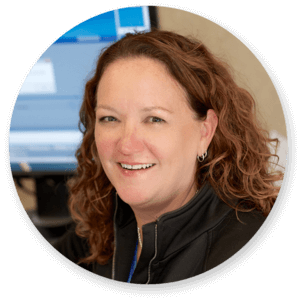8 min read
A Conversation With Lori Zindl, President of efficientC and OS, inc.
By: efficientC News Team on Oct 25, 2021 3:35:20 PM

You have developed two companies over the course of your career: Outsource, Inc., and efficientC. Can you describe how each of your companies came to be and what you were hoping to accomplish with each?
The first company I started was Outsource, Inc., which provides business office support services. I began my career as a medical bill collector and eventually went on to do some healthcare consulting, some training, and even spent some time as the director of a large hospital in Indianapolis. During that time, I learned that the quantity and complexity of healthcare billing rules are often beyond the ability of hospital staff to manage and understand.
So I set out to meet the needs of healthcare billing offices by building a company that offers both full and partial business office support services. For the first twenty years, I contracted with a number of vendors for my clearinghouse and claim scrubber. But I never had a contract that lasted for more than three years, because the companies would get bought out or their level of service would decline.
The last straw was in 2008, when Medicaid made a new rule in Wisconsin that took our vendor over a month to get right. In the meantime, one of our clients didn’t receive a Medicaid check. So, a couple of million dollars later, I found myself saying, “It’s my vendor’s fault.” But that’s really my fault, because I picked the vendor.
That’s when we decided that this piece of technology was too important to leave in somebody else’s hands. To make sure that our claims would get paid for our customers, we built our own clearinghouse and claim scrubber. That’s where efficientC, the second company, comes from. We built our dream system to make everyone’s lives easier, and everyone gave input on how to build it. It even includes analytic and decision support tools that allow hospital leaders to identify patterns and issues that can be solved by making changes further upstream.
In what ways does efficientC reach beyond the business office to support leadership in decision making?
The answer to this one really lies in our analytics tool. It’s part of the claim scrubber clearinghouse in efficientC, but can also be used without efficientC. Using data extracted from the claim file and the remittance file from the payer, the tool can help CFOs forecast what their cash flow is going to look like based on the claims that are going out the door.
We’re also able to grab information like the coder or the registrar on the account. When we start to see denials related to coding or eligibility, we can now report those denials by person to help pinpoint opportunities for additional training.
As another example, we can sort medical necessity denials by physician. A medical necessity denial doesn’t necessarily mean that the doctor is requesting services that are not medically necessary. They’re generally just missing the supporting documentation. Once organization leaders have this information, it’s simple to communicate with relevant physicians about sufficiently documenting why they are providing services.
How do you see each of these companies making an impact on healthcare orgs and patients they serve?
When people ask me what I do, I always say, “Have you ever gotten a bill 6 months after you’ve had services? And it took 6 months to arrive, and then it was wrong?” That’s terrible for patient satisfaction. Typically, it happens because the claim goes out wrong and then requires another rebill before they get it right. Generally speaking, 20-25% of healthcare claims deny on first submission.
But our clients have an average of about 8%, and that includes clients who are new on the system. We have clients who are getting 95% of their claims to pay on first submission. That improves your cash flow, that improves patient relations, the claims are getting paid right, the bills are getting out to the patient sooner, and that means patients have an opportunity to pay them sooner. These are all huge impacts for both patients and healthcare organizations.
Do your billers at OS inc. use efficientC?
They do. And our billers are always a little happier when they know they’re working on a project that allows them to use efficientC. Although they will gladly work in whichever systems our clients use, they feel especially at home working in efficientC. It makes their lives easier.
This is a big deal. The fact that we ourselves use the product for our business ensures that it is a top-notch system. I know that it’s clean and that it offers everything we need to do our job well. We know it works really well for our customers because it works really well for us.
What do OS inc. staff love about using efficientC? What makes your product stand out among clearinghouse claim scrubbers?
It truly is a system that was designed by billers for billers. Everything a biller needs t

o do his or her job is available--including a copy of the claim that was billed as well as the remittance from the payer. efficientC features a user-friendly, intuitive workflow with simple navigation and easily accessible documentation.
Most importantly, the workflow within efficientC allows billers to work denials by type. This allows them to focus, for example, on just eligibility denials or just medical necessity denials. Most systems don’t work that way. Instead, denials must be worked by dollar amount or by payer, for example.
These strategies can be fine, but we found that when denials were not organized by type, we were able to work an average of about 10 denials per hour. Now, because we can focus on one denial type at a time, we’re working 15-20 denials per hour.
What are some of the biggest challenges for healthcare revenue cycles in the wake of the COVID-19 pandemic?
Shortly after the pandemic began, many hospitals were forced to reduce services, and their revenue dropped significantly. The recovery has been tough, so financially, that’s been a significant challenge.
Additionally, business offices were not prepared for remote work, and a lot of them didn't have laptops available for people. We got a lot of phone calls in the beginning saying “I need help, my business office is shut down,” because if someone got COVID-19 in their office, they all had to go home. But they weren’t equipped to work from home.
On top of that, vaccine mandates are impacting both the clinical and business office side because they’re losing staff. In fact, we’re at a point where people are losing a third of their staff, and they’re wanting us to fill it.
How have your companies had to pivot to continue providing a high level of service to your customers?
Even though it was a learning curve, we adapted quickly to remote work and making sure people had a great place to work at home. We’ve also been continuing to hire people to help meet the demand of our customers. Now, being able to offer a hybrid staffing model has really opened up our hiring pool to the entire nation. So each of these adjustments is allowing us to support those customers whose workers are either unable to work remotely or unwilling to comply with vaccine mandates.
We have also expanded our external training services to include training modules that cover basics like how to do insurance follow-up, how to work through denials, and generally how to do the business office work. Hospitals are always looking for people with experience, but as a result of the pandemic, that pool is getting thinned out quite a bit. Our online training services can help hospitals to onboard new business office staff who may not have much previous experience.
What advice would you give to revenue cycle leaders who are looking to partner with vendors who offer the services you offer?
Seek out vendors that are true partners and who are contractually driven by results, we want to be accountable. For example, on the efficientC side, we design our contracts so that our support team is rated on the percent of clients that are getting more than 90% of their claims paid on first submission. The same is true on our services side. In our contracts, we’ll either include targets for GDRO, aging, collections, etc. or we will set up a contingency-base model where we will get a percentage on the claims that get paid.
It’s also important to find a partner who does not charge every time a custom rule is requested. It has always struck me as odd when vendors would want to charge me for improving their product. I was paying for a claims scrubber. It should know those rules. I shouldn’t have to tell them.
What do you see as the future of the healthcare business office right now?
I would like to see the overall responsibility of the business office be reduced, because the business office isn’t even responsible for the majority of fields on a claim form. 57% of the fields are filled out by registration and patient access, and another third by coding. We need to be focusing our time and energy on getting claim form data right up front.
If we get the data right on the front end, the future of the business office gets cut in half. I don’t mean to say that we want to eliminate those positions, but that would allow us to shift those resources up front. For example, if a large hospital has 20% of their claims denied, and they’re able to move that down to 5%, they have literally reduced the number of people required on the back end.

What does the future hold for your companies? How do you envision them shifting and growing?
For our analytics tool, we really enjoy adding more bells and whistles. So we’ll continue to do that. Every time we add a new one and release it to our clients, it’s so much fun to hear their excitement.
We are also working on adding robotic process automation into our services side. For some of the more straight-forward denials, we want to automate certain actions so that a staff member wouldn’t necessarily need to be involved right away.
In healthcare RCM, we are always being asked to do more with less and reimbursement from payers continues to shrink. We need to continue to find ways to reduce the cost to collect by improving first pass payment rates and process automation where we can.
If you'd like to hear more, let us know! Reach out to us here.
Do not forget to subscribe to Revenue Cycle Matters for healthcare billing best practices and industry tips!
Related Posts
7 Things Business Office Staff Can Do Now to Increase Efficiency and Cash Flow
We asked the highly experienced revenue cycle team here at OS Inc. what healthcare leaders can do...
Are You Putting This Type of PHI in Your Emails? You Shouldn’t Be.
Cyber security remains a hot topic in the world of health data. When it comes to patient privacy,...
Our Best Tips for Effectively Training New Business Office Staff
Rural hospitals and businesses in the United States are facing a challenge. Population growth in...
